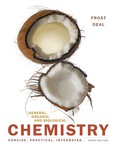
EBK GENERAL, ORGANIC, AND BIOLOGICAL CH
3rd Edition
ISBN: 8220101460288
Author: Deal
Publisher: PEARSON
expand_more
expand_more
format_list_bulleted
Concept explainers
Question
Chapter 2, Problem 2.9PP
Summary Introduction
To determine:
The mass number of nitrogen.
Introduction:
The mass number of the atom is the sum of mass of proton and neutron in the atom
Expert Solution & Answer
Want to see the full answer?
Check out a sample textbook solution
Chapter 2 Solutions
EBK GENERAL, ORGANIC, AND BIOLOGICAL CH
Ch. 2 - Where are the subatomic particles located in an...Ch. 2 - Prob. 2.2PPCh. 2 - Prob. 2.3PPCh. 2 - Prob. 2.4PPCh. 2 - How can you determine the following? a. the number...Ch. 2 - What can be determined from the following? a. the...Ch. 2 - Provide the name and atomic symbol of the element...Ch. 2 - Provide the name and atomic symbol of the element...Ch. 2 - Prob. 2.9PPCh. 2 - Prob. 2.10PP
Ch. 2 - Determine the number of protons, neutrons, and...Ch. 2 - Determine the number of protons, neutrons, and...Ch. 2 - Prob. 2.13PPCh. 2 - Prob. 2.14PPCh. 2 - Prob. 2.15PPCh. 2 - Prob. 2.16PPCh. 2 - Prob. 2.17PPCh. 2 - How are atomic mass and mass number similar? How...Ch. 2 - There are three naturally occurring isotopes of...Ch. 2 - Prob. 2.20PPCh. 2 - Prob. 2.21PPCh. 2 - Prob. 2.22PPCh. 2 - Prob. 2.23PPCh. 2 - Prob. 2.24PPCh. 2 - Prob. 2.25PPCh. 2 - Prob. 2.26PPCh. 2 - Prob. 2.27PPCh. 2 - Prob. 2.28PPCh. 2 - Prob. 2.29PPCh. 2 - Prob. 2.30PPCh. 2 - Prob. 2.31PPCh. 2 - Prob. 2.32PPCh. 2 - What does the unit sievert measure?Ch. 2 - Prob. 2.34PPCh. 2 - Prob. 2.35PPCh. 2 - Prob. 2.36PPCh. 2 - Prob. 2.37PPCh. 2 - Prob. 2.38PPCh. 2 - Prob. 2.39PPCh. 2 - Prob. 2.40PPCh. 2 - Prob. 2.41PPCh. 2 - Prob. 2.42PPCh. 2 - Prob. 2.43PPCh. 2 - Prob. 2.44PPCh. 2 - Complete the following statements: a. A...Ch. 2 - Complete the following statements: a. The mass...Ch. 2 - Prob. 2.47APCh. 2 - Prob. 2.48APCh. 2 - Prob. 2.49APCh. 2 - Prob. 2.50APCh. 2 - Prob. 2.51APCh. 2 - Prob. 2.52APCh. 2 - Prob. 2.53APCh. 2 - Prob. 2.54APCh. 2 - Prob. 2.55APCh. 2 - Prob. 2.56APCh. 2 - Prob. 2.57APCh. 2 - Prob. 2.58APCh. 2 - Prob. 2.59APCh. 2 - Prob. 2.60APCh. 2 - Prob. 2.61APCh. 2 - Prob. 2.62APCh. 2 - Prob. 2.63APCh. 2 - Prob. 2.64APCh. 2 - Prob. 2.65APCh. 2 - Prob. 2.66APCh. 2 - Prob. 2.67APCh. 2 - Prob. 2.68APCh. 2 - A 25-mL sample of chromium-51 contains 1.00 mCi....Ch. 2 - Prob. 2.70APCh. 2 - Prob. 2.71APCh. 2 - Prob. 2.72APCh. 2 - Prob. 2.73APCh. 2 - Prob. 2.74APCh. 2 - Prob. 2.75APCh. 2 - Prob. 2.76APCh. 2 - Prob. 2.77CPCh. 2 - Prob. 2.78CPCh. 2 - PET scans are useful for imaging areas of high...Ch. 2 - Prob. 1IA.1QCh. 2 - Prob. 1IA.2QCh. 2 - Prob. 1IA.3QCh. 2 - Prob. 1IA.4QCh. 2 - Prob. 1IA.5QCh. 2 - Prob. 1IA.6QCh. 2 - Prob. 1IA.7QCh. 2 - Prob. 1IA.8QCh. 2 - Prob. 1IA.9QCh. 2 - Prob. 1IA.10QCh. 2 - Prob. 1IA.11QCh. 2 - Prob. 2IA.1QCh. 2 - Prob. 2IA.2QCh. 2 - Prob. 2IA.3QCh. 2 - Prob. 2IA.4QCh. 2 - Prob. 1ICCh. 2 - Prob. 2IC
Knowledge Booster
Learn more about
Need a deep-dive on the concept behind this application? Look no further. Learn more about this topic, chemistry and related others by exploring similar questions and additional content below.Similar questions
- How did the charge distribution in the plum pudding model affect alpha particles passing through an atom?arrow_forward2.10 Which isotope in each pair contains more neutrons? (A) 35Cl or 33S, (b) 19F or 19Ne, (c) 63Cu or 65Zn, (d) 126I or 127Tearrow_forwardWhat is the mass number of an atom with 60 protons, 60 electrons, and 75 neutrons? a. 120 b. 135 c. 75 d. 195arrow_forward
- Explain the operation of a cathode-ray tube. Describe the deflection of cathode rays by electrically charged plates placed within the cathode-ray tube. What does this imply about cathode rays?arrow_forward40K is used to measure the age of Earth. Determine the number of protons and neutrons in 40K.arrow_forwardXenon An isotope of xenon has an atomic number of 54 and contains 77 neutrons. What is the xenon isotope’s mass number?arrow_forward
arrow_back_ios
SEE MORE QUESTIONS
arrow_forward_ios
Recommended textbooks for you
 Chemistry for Today: General, Organic, and Bioche...ChemistryISBN:9781305960060Author:Spencer L. Seager, Michael R. Slabaugh, Maren S. HansenPublisher:Cengage LearningChemistry: Matter and ChangeChemistryISBN:9780078746376Author:Dinah Zike, Laurel Dingrando, Nicholas Hainen, Cheryl WistromPublisher:Glencoe/McGraw-Hill School Pub Co
Chemistry for Today: General, Organic, and Bioche...ChemistryISBN:9781305960060Author:Spencer L. Seager, Michael R. Slabaugh, Maren S. HansenPublisher:Cengage LearningChemistry: Matter and ChangeChemistryISBN:9780078746376Author:Dinah Zike, Laurel Dingrando, Nicholas Hainen, Cheryl WistromPublisher:Glencoe/McGraw-Hill School Pub Co
 General Chemistry - Standalone book (MindTap Cour...ChemistryISBN:9781305580343Author:Steven D. Gammon, Ebbing, Darrell Ebbing, Steven D., Darrell; Gammon, Darrell Ebbing; Steven D. Gammon, Darrell D.; Gammon, Ebbing; Steven D. Gammon; DarrellPublisher:Cengage Learning
General Chemistry - Standalone book (MindTap Cour...ChemistryISBN:9781305580343Author:Steven D. Gammon, Ebbing, Darrell Ebbing, Steven D., Darrell; Gammon, Darrell Ebbing; Steven D. Gammon, Darrell D.; Gammon, Ebbing; Steven D. Gammon; DarrellPublisher:Cengage Learning Chemistry & Chemical ReactivityChemistryISBN:9781133949640Author:John C. Kotz, Paul M. Treichel, John Townsend, David TreichelPublisher:Cengage Learning
Chemistry & Chemical ReactivityChemistryISBN:9781133949640Author:John C. Kotz, Paul M. Treichel, John Townsend, David TreichelPublisher:Cengage Learning

Chemistry for Today: General, Organic, and Bioche...
Chemistry
ISBN:9781305960060
Author:Spencer L. Seager, Michael R. Slabaugh, Maren S. Hansen
Publisher:Cengage Learning


Chemistry: Matter and Change
Chemistry
ISBN:9780078746376
Author:Dinah Zike, Laurel Dingrando, Nicholas Hainen, Cheryl Wistrom
Publisher:Glencoe/McGraw-Hill School Pub Co


General Chemistry - Standalone book (MindTap Cour...
Chemistry
ISBN:9781305580343
Author:Steven D. Gammon, Ebbing, Darrell Ebbing, Steven D., Darrell; Gammon, Darrell Ebbing; Steven D. Gammon, Darrell D.; Gammon, Ebbing; Steven D. Gammon; Darrell
Publisher:Cengage Learning

Chemistry & Chemical Reactivity
Chemistry
ISBN:9781133949640
Author:John C. Kotz, Paul M. Treichel, John Townsend, David Treichel
Publisher:Cengage Learning